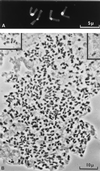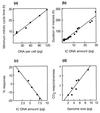Plant genome values: how much do we know?
- PMID: 9482826
- PMCID: PMC33834
- DOI: 10.1073/pnas.95.5.2011
Plant genome values: how much do we know?
Abstract
Plants are the basis of life on earth. We cannot overemphasize their importance. The value of plant genome initiatives is self-evident. The need is to identify priorities for action. The angiosperm genome is highly variable, but the extent of this variability is unknown. Uncertainties remain about the number of genes and the number of species living. Many plants will become extinct before they are discovered. We risk losing both genes and vital information about plant uses. There are also major gaps in our karyotypic knowledge. No chromosome count exists for >70% of angiosperm species. DNA C values are known for only approximately 1% of angiosperms, a sample unrepresentative of the global flora. Researchers reported new relationships between genome size and characters of major interest for plant breeding and the environment and the need for more data. In 1997, a Royal Botanic Gardens Kew workshop identified gaps and planned international collaboration to fill them. An electronic version of the Angiosperm DNA C value database also was published. Another initiative, which will make a very significant contribution to the conservation of plant genetic diversity on a global scale is Kew's Millennium Seed Bank, partly funded by the U.K. Millennium Commission, celebrating the year 2000. Costing up to 80 million (1 = $1.62), its main aims are to collect and conserve the seed of almost all of the U.K. spermatophyte flora by the year 2000, to collect and conserve a further 10% of the world spermatophyte flora principally from the drylands by 2009, and to provide a world class building as the focus of this activity by 2000.
Figures


References
-
- Cohen J. Science. 1997;275:769.
-
- Heslop-Harrison J S. J Cell Sci. 1991;100:15–21.
-
- Index Kewensis (1997) Oxford Univ. Press, Oxford.
-
- Dransfield J, Beentje H. The Palms of Madagascar. Kew and the International Palm Society, Kew, U.K.: Royal Botanic Gardens; 1995.
LinkOut - more resources
Full Text Sources
Other Literature Sources

